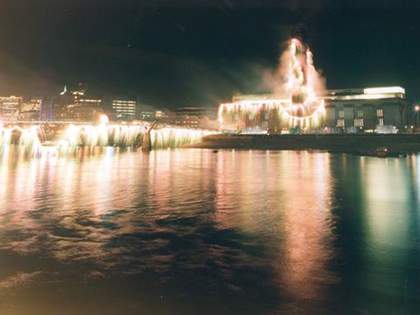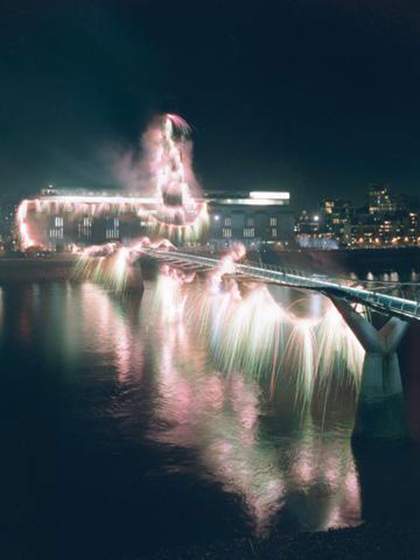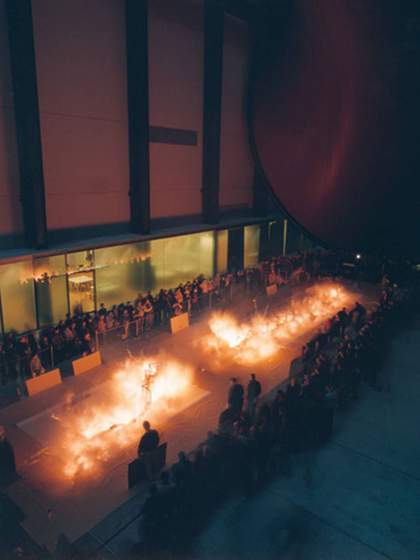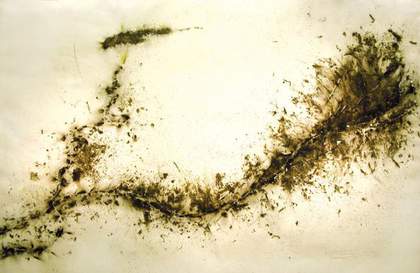Ye Gong Hao Long (Mr Ye Who Loves Dragons): Explosion Project for Tate Modern was a live artwork by the Chinese artist Cai Guo-Qiang. It was composed of two separate events that took place on 29 and 31 January 2003, launching the Tate & Egg Live programme and celebrating Chinese New Year. The first event took place inside the Turbine Hall at Tate Modern for which the artist created drawings using gunpowder. The second event was a controlled explosion that surged along the length of the Millennium Bridge across the River Thames outside the museum before traversing the façade of Tate Modern. The commission explored the fleeting and ephemeral nature of spectacles.
For the first event on 29 January, Cai produced two gunpowder ‘drawings’ in front of an audience gathered in the Turbine Hall. Cai used firework fuses to leave an exploded mark on paper. The fuses, made up of gunpowder, were lit by a slow-burning stick of incense, which exploded with bright light, loud sound and thick smoke. The shape and direction of the blaze was controlled by cardboard weights on the paper support. The paper, traditionally produced in Japan, was particularly thick and fibrous meaning it could withstand and absorb both the heat and impact of the combustion. These drawings, which are now part of Tate’s collection, were put on display – accompanied by free jasmine tea and fortune cookies – for audiences who came to see the second explosion piece.
For the second event Cai created a thirty-second explosion, formed by igniting 6,000 metres of fuse, twenty-five kilograms of black and metallic fire powders and 200 shells. The exploding gunpowder trail, which represented a dragon moving at great speed, travelled across the Millennium Bridge and up Tate Modern’s river façade, before winding around the building’s tower and finally burning out in a cloud of smoke. In Chinese culture the dragon is an auspicious image with connotations of success and prosperity, whereas in the West it is more likely to be equated with destruction and aggression. The first half of the title for the commission, Ye Gong Hao Long (Mr Ye Who Loves Dragons), is inspired by a popular Chinese idiom used to describe a person whose appreciation of a subject is revealed to be superficial. The idiom derives from a fable about a man called Mr Ye who loved dragons so much that it became known throughout the kingdom. However, when a real dragon heard about him and flew to his house to visit, Mr Ye was so petrified that he ran away. The meaning of the work is allegorical; Cai wrote in his project proposal that the allegory allows for a multiplicity of meanings, ‘such as the Western attitude towards the East, especially modern day China; the Museum’s invitation for the artist and his project; or even the artist’s deprecating humor towards his own history of tirelessly using dragons as subject matter’.1
Explosions of this kind have become a speciality of Cai’s practice. Growing up in the Fujian province of China, which is itself famous for the manufacture of fireworks, the form has long been important to the artist. As he has written: ‘In China every significant social occasion of any kind, good or bad – weddings, funerals, the birth of a baby, a new home – is marked by the explosion of fireworks … I saw gunpowder used in both good ways and bad, in destruction and reconstruction. Gunpowder was invented in China as a by-product of alchemy.’2
Although the moment of explosion is spectacular, the moments afterwards offer a time for reflection – an effect which is simulated in these events. Indeed, this extends to Cai, as he relinquishes mastery or control and embraces the risk and unpredictability of an explosion. He commented: ‘The idea was to derive energy from nature. Out of that came the idea of investigating the accidental, that which cannot be controlled.’3
Philomena Epps
April 2016





